If you’re a digital nomad dreaming of living in Japan but are unsure of where to stay, then look no further than Osaka. From its stunning architecture to its delicious cuisine and thriving nightlife, this vibrant city is the perfect place to explore while living and working abroad as a digital nomad. But, before you buy your airplane ticket, you first need to figure out the logistics of living in Osaka.
Osaka is one of my favorite cities in the entire world. Not only have I visited this thrilling city countless times as a child, but I also spent most of my year living abroad in Japan, in Osaka. It’s a great city to live in for digital nomads.
And even though the city has a reputation for being upbeat and exciting, it also offers a laid-back lifestyle that’s perfect for all the introverts out there (like me).
So today, I will outline everything that you need to know about living in Osaka. From finding accommodations and co-working spaces to exploring the city’s unique attractions, this article will help you get settled into your new and exhilarating life in Osaka and the Kansai region. This is my ultimate digital nomad guide to Osaka. Let’s begin:
About Osaka
Before we dive into the details of living in Osaka, let’s go over some basic facts about the city. Located in the Kansai Region west of Tokyo, Osaka is the third-largest city in Japan (after Tokyo and Yokohama), housing nearly 2.7 million people over 225 square kilometers.
Osaka is also a port city, located next to the sparkling Osaka Bay. With its origins spreading back to the 5th century, Osaka is filled with history. I definitely recommend visiting Shitenno-ji Temple if possible; it’s the first Buddhist temple in Japan to be built by the government.
In the 15th century, the city officially became known as Osaka, where it thrived as a transportation and military center. In 1583, the majestic Osaka Castle was built. Osaka is a bustling city filled with an interesting past and current culture.
Living in Osaka As a Digital Nomad
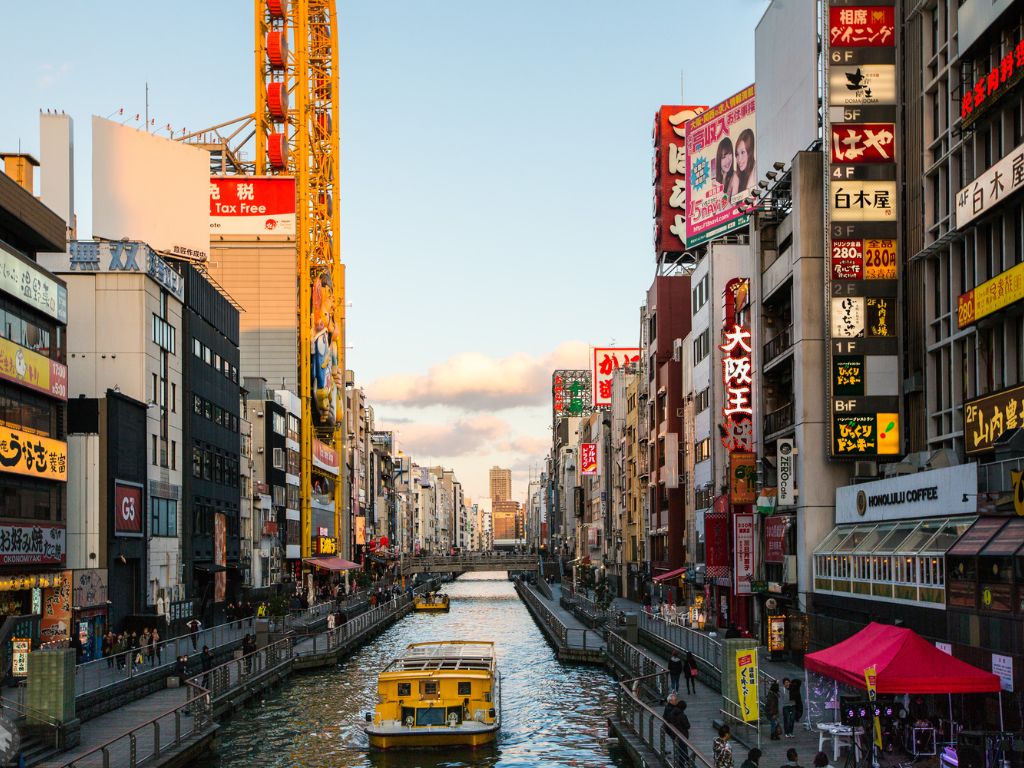
Now, you may be wondering what being a digital nomad in Osaka is like. While Osaka is often overlooked compared to Tokyo, it definitely deserves more recognition.
Not only is it more affordable than Tokyo, with many budget housing options available, but it’s also located conveniently close to Nara and Kyoto; two stunning cities filled with spectacular natural and cultural sites.
Famous for its bright and bustling downtown spots (such as Namba and Dotonbori), which are filled with flashing neon signs and crowded bars, Osaka is heaven for any extrovert who enjoys nightlife. In contrast, it also offers quieter and more picturesque spots, such as the tranquil Osaka Castle Park and the beautiful Osaka Bay area.
Within Japan, Osakans have a reputation for being boisterous, friendly, and laid-back. They are also known to have a good sense of humor and many major Japanese comedians are from Osaka.
Furthermore, there’s a growing digital nomad community in Osaka, with new co-working spots constantly popping up throughout the city.
With mouthwatering local dishes such as okonomiyaki (a savory pancake made from cabbage and seafood) and takoyaki (bits of grilled octopus in a savory ball), it’s also the perfect destination for all the foodies among you. As you can see, Osaka offers a bit of everything, making it one of the best places to live in Japan.
Is Osaka Safe?
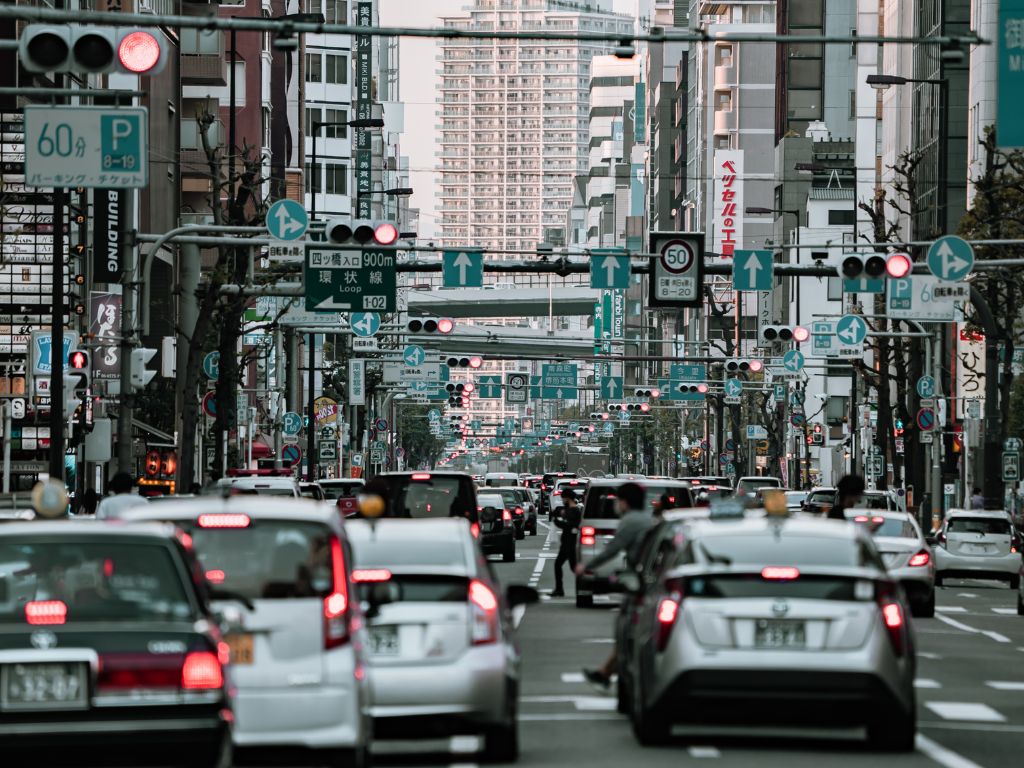
Even though Osaka is a large, bustling, and lively city, it is still considered to be one of the safest cities in the world. The overall crime rates are low, taxis are secure and dependable, and I’ve never had any run-ins with pick-pockets, scams, or petty thievery.
Even when my travel companion lost his GPS on a train, we were able to find and retrieve it easily from Osaka Station lost and found.
Of course, crime still takes place in Osaka, but, as long as you follow your instincts and take normal precautions, the city is extremely safe. That being said, I would avoid the Kamagasaki (Airinchiku) neighborhood.
While Osaka (and Japan in general) has low crime rates, it is prone to natural disasters. Osaka is particularly vulnerable to earthquakes, typhoons, tsunamis, and flooding. To stay safe, I recommend keeping up-to-date with local news and weather forecasts and reviewing safety procedures in the event of these circumstances.
Nevertheless, I wouldn’t worry too much about it. During my year living abroad in Japan, I only experienced the smallest earthquake in Osaka, which hardly anyone felt. Needless to say, Osaka is a very safe city.
Best Places to Live in Osaka
Now that we’ve covered some basic facts about Osaka, let’s get into the various neighborhoods Osaka has to offer. Here are the 5 best places to live in Osaka:
1. Kita (Umeda)
First up, one of the best areas for living in Osaka is undoubtedly Kita (Umeda). Located in northern Osaka, (kita literally translates to north), it’s centered around Umeda/Osaka train station, which is the largest in Osaka.
This makes living in Kita (Umeda) super convenient, as Umeda/Osaka Station has JR and non-JR lines (both local and rapid) that take you around the entire city and to top destinations outside of Osaka, including Kyoto, Nara, Kobe, and Himeji.
Furthermore, Kita (Umeda) is Osaka’s business center and offers a wide variety of shopping and dining spots. Since Kita (Umeda) is such a thriving and popular area in downtown Osaka, housing can be more expensive and competitive. So, it’s likely not the best choice if you’re a more budget-minded digital nomad.
Nevertheless, with several co-working spaces including WeWork LINKS UMEDA, ONthe UMEDA, and Coworking & Shareoffice Reqree Dojima, lovely parks, and a relaxing vibe, it’s one of my favorite places to stay in Osaka.
2. Minami (Namba)
Next, if you want to stay in Osaka’s center for entertainment, activities, and nightlife, then you have to stay in Minami (Namba). Located in southern Osaka (minami translates to south), there’s an abundance of things to do here.
For instance, I recommend visiting the Kuromon Ichiba Market, the Shinsaibashi Shopping Arcade, the Namba Yasaka Shrine, and the various shops and restaurants in the Dotonbori area.
There are many lovely cafes perfect for working remotely, and while this included some chain coffee shops such as Doutor, Starbucks, and Kiefel Coffee, I also found plenty of independent cafes in the area too. Since there are so many tourists in Minami (Namba), it’s easy to find other digital nomads and travelers if you’re seeking company.
Minami (Namba) is a lively and bustling area of Osaka and can become quite noisy at night. I found myself getting pretty overwhelmed by the crowds while staying at an Airbnb in the center of Namba. There weren’t many areas where I could avoid the swarms of visitors. So, if you’re looking for a quieter spot for your home base, then this may not be the place for you.
But, if you thrive in these sorts of environments and love being in such an energetic and thriving center, then Minami (Namba) could be the perfect choice for you when deciding where to live as an Osaka digital nomad.
3. Tennoji
If you’re a digital nomad looking for budget accommodations in the city, then I recommend looking at the options in Tennoji. Not only is Tennoji an economic hub filled with shops and restaurants, but it also offers quieter areas in Tennoji Park and Shitenno-ji Temple. For those watching their wallets, Tennoji offers some of the cheapest accommodations in Osaka.
Tennoji is one of my favorite places to stay in Osaka. Centered around Tennoji Station, which has several convenient train lines that travel within and out of Osaka, Tennoji offers a bit of everything; historic temples, bustling malls, delightful art galleries, and trendy cafes.
While it used to have a seedy reputation, over the past few decades, Tennoji has been transforming into one of Osaka’s biggest economic centers.
And since Tennoji is one of the most affordable places to stay in the city, you’re likely to find many other digital nomads to meet up with. Furthermore, there are several co-working spaces available; I recommend checking out Work Place Cocolo Abeno Matsuzakicho.
4. Osaka Castle Area
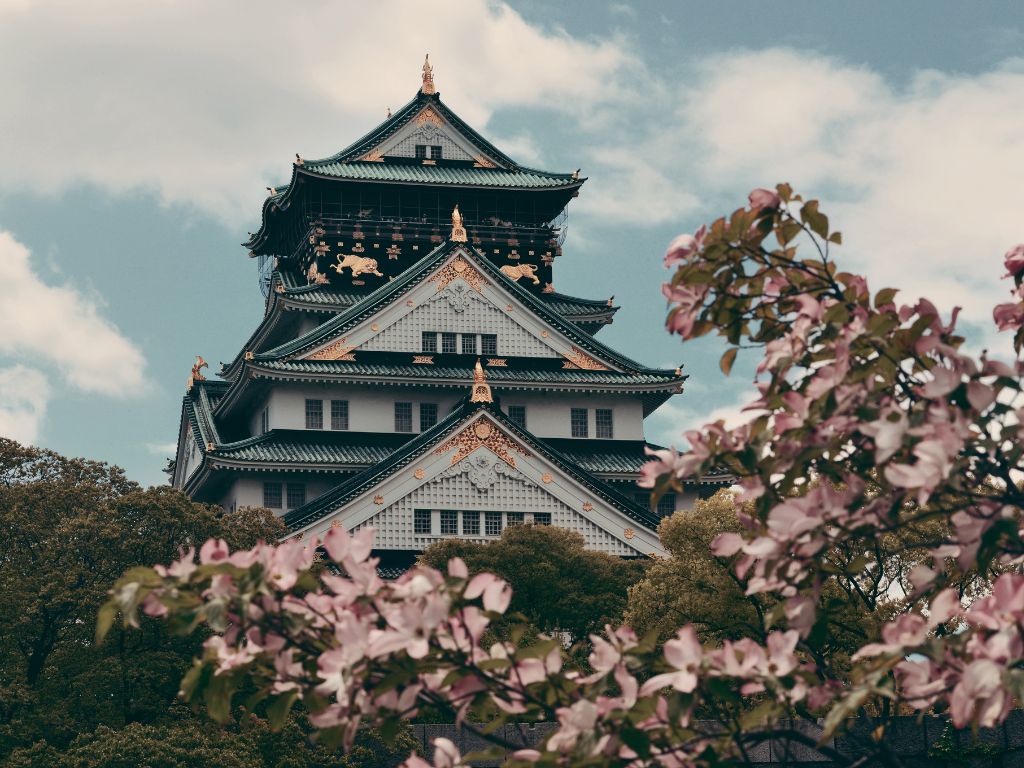
If you’re looking for a quieter place to stay in Osaka, then I highly recommend checking out the Osaka Castle Area. As the name implies, this area is centered around Osaka Castle.
While the castle is one of Osaka’s top attractions, its vast park is filled with gardens, fields, a moat, and cherry and plum blossoms, making it an enchanting and serene location – it’s one of my favorite spots in Osaka.
This area sees fewer visitors than the other neighborhoods of Osaka that I’ve listed so far, which makes it ideal for digital nomads and travelers who want to retreat from the hustle and bustle of downtown. And, while housing costs more in the Osaka Castle area than in Tennoji, it is cheaper than in Kita (Umeda) and Minami (Namba).
There are several quaint and cozy cafes in the area that offer great working environments, but these do tend to close earlier than the cafes in Umeda, Namba, and Tennoji. What’s convenient is that if you find the Osaka Castle area to be a bit too laid-back and quiet, it’s easy to take a train to the bustling neighborhoods of Umeda, Namba, and Tennoji.
Overall, the Osaka Castle area is the perfect place to live if you prefer more tranquil and relaxing neighborhoods.
5. Osaka Bay Area
Last but not least, one of the best neighborhoods for living in Osaka as a digital nomad is the Osaka Bay area. It’s one of the most beautiful areas of Osaka and offers truly stunning views of the Osaka Bay and the city’s skyline.
It’s the furthest neighborhood on this list from downtown Osaka (note that downtown consists of Kita (Umeda), Minami (Namba), and Tennoji). So, if you want to be closer to the action, then the Osaka Bay area may be a little far out for you. There also aren’t many co-working spaces in the Osaka Bay area, which depending on your preference may be a good or bad thing.
There are a fair amount of foreigners living in the Osaka Bay area because many expats work at Universal Studios Japan. And since it’s further away from downtown, the cost of housing is reasonably priced and more affordable. Overall, while the Osaka Bay area has fewer amenities for digital nomads, it’s one of the most gorgeous areas of Osaka and worth looking into.
How to Find Accommodation in Osaka
Now that I’ve listed the best neighborhoods for living in Osaka, let’s discuss how to find accommodations in Osaka. Here are 5 different ways to find housing in Osaka:
1. Airbnb: Offering short and long-term options, Airbnb allows travelers to pay homeowners to stay in their homes and apartments. It’s my preferred method for finding long-term accommodations as a digital nomad because it’s the easiest choice and I don’t have to worry about security deposits, contracts, or opening a foreign bank account.
2. Facebook Groups: Another convenient way to find housing in Osaka is through Facebook Groups, with several Osaka-based groups posting English- and foreigner-friendly listings. This is also a great way to connect with fellow expats. Some options include Osaka Housing, Rooms, Apartments, Sublets for rent, buy, sell, and Osaka Apartment Hunting/Share Housing Group.
3. Social Apartment: If you’re thinking of staying in a house share, then I recommend checking out Social Apartment. Offering private rooms with modern and stylish communal areas, Social Apartment is a great and reliable company that helps you find comfortable housing. Plus, staying in a share house makes it easier to form relationships with other digital nomads.
4. Best-Estate.JP: Focused on aiding foreign residents in finding housing in Japan, Best-Estate.JP is a trustworthy company that helps you secure your apartment before you arrive in Japan.
5. GaijinPot Apartments: While finding housing as a digital nomad can be difficult, GaijinPot Apartments can help you out. A foreigner- and English-friendly website filled with available apartment listings all over Japan, GaijinPot Apartments simplifies apartment hunting for you. However, it can be harder to find cheaper apartments this way.
Cost of Living in Osaka
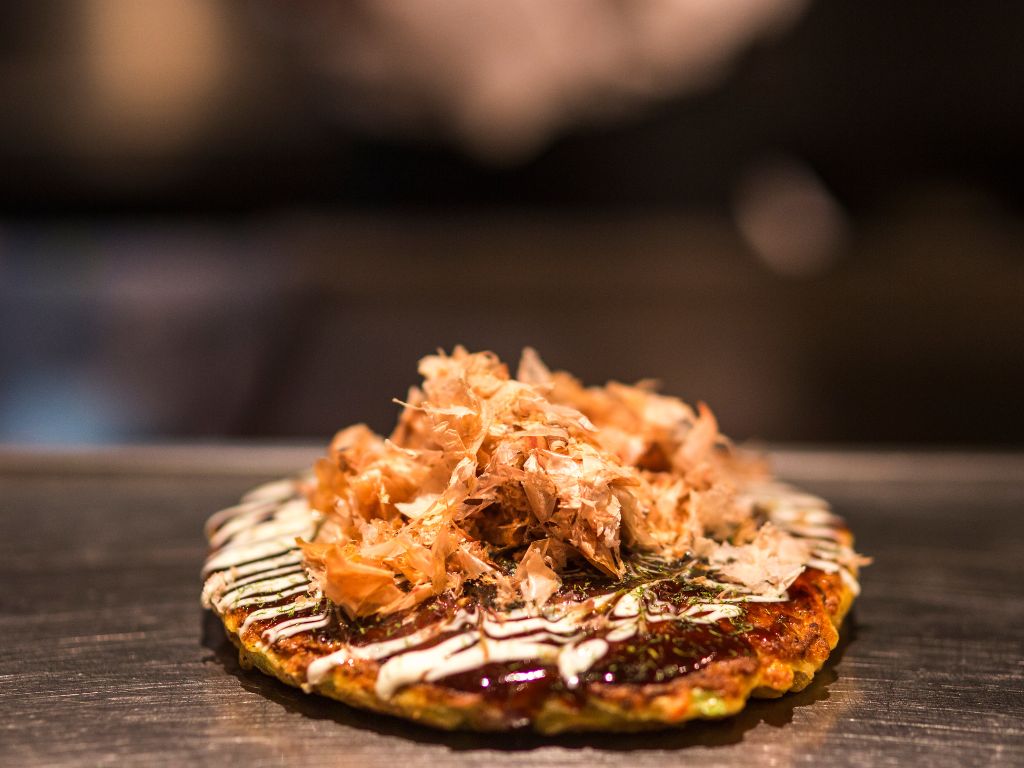
At this point, you may be wondering if you can even afford to live in Osaka. After all, Japan does have a reputation for being an expensive destination to travel to.
While people tend to view Japan as a pricey and higher-end country, it isn’t. I actually find it more affordable than a lot of the other countries I’ve visited and lived in. To you an idea of what you can expect, here’s a breakdown of the cost of living in Osaka:
Restaurants and Groceries
First, let’s go over the cost of food in Osaka. Eating out at a budget restaurant should cost less than 1,000 JPY ($7.15 USD) per person, while a mid-range restaurant would cost less than 2,890 JPY ($20.70 USD) per person. Tipping at restaurants also isn’t expected in Japan so there aren’t any additional costs in that sense.
One liter of milk costs around 197 JPY ($1.41 USD), one loaf of bread costs around 191 JPY ($1.36 USD), a carton of eggs costs around 265 JPY ($1.90 USD), one kilogram of cheese costs around 1,345 JPY ($9.64 USD), half a liter of domestic beer costs around 450 JPY ($3.22 USD), and a mid-range bottle of wine costs around 1,500 JPY ($10.74 USD). For more grocery costs, check out this website.
As you can see, groceries are quite affordable in Osaka. Living in Canada, I miss the prices of tofu, udon, fruit jelly, and Japanese curry compared to the costs in Japan. That being said, the fruit in Japan can be crazy expensive; during my time there, I mostly opted to eat kiwi to reduce my grocery bills.
Accommodation Costs
Next, let’s go over the cost of accommodations in Osaka. In the center of Osaka, the average rent for a one-bedroom apartment is $611.42 USD per month, while the average rent for a three-bedroom apartment is $1,648.22 USD. Outside of the city center, the average rent for a one-bedroom apartment is $370.43 USD. Learn more here.
If you look into finding a place on Airbnb, you can find dormitory rooms for around $265 USD per month, private rooms in guesthouses from $368 USD per month, and fully-private apartments from $630 USD per month. These costs can vary, but it’s always worth checking Airbnb first.
Remember that housing costs vary a lot depending on where you’re staying. The cheapest neighborhood is Abeno (near Tennoji), with a studio costing an average of 43,000 JPY ($308 USD) per month. In contrast, the most expensive neighborhood is Kita (Umeda), with a studio costing an average 56,000 JPY ($400 USD) per month.
Overall, apartments can be quite affordable in Osaka.
Transportation Costs in Osaka
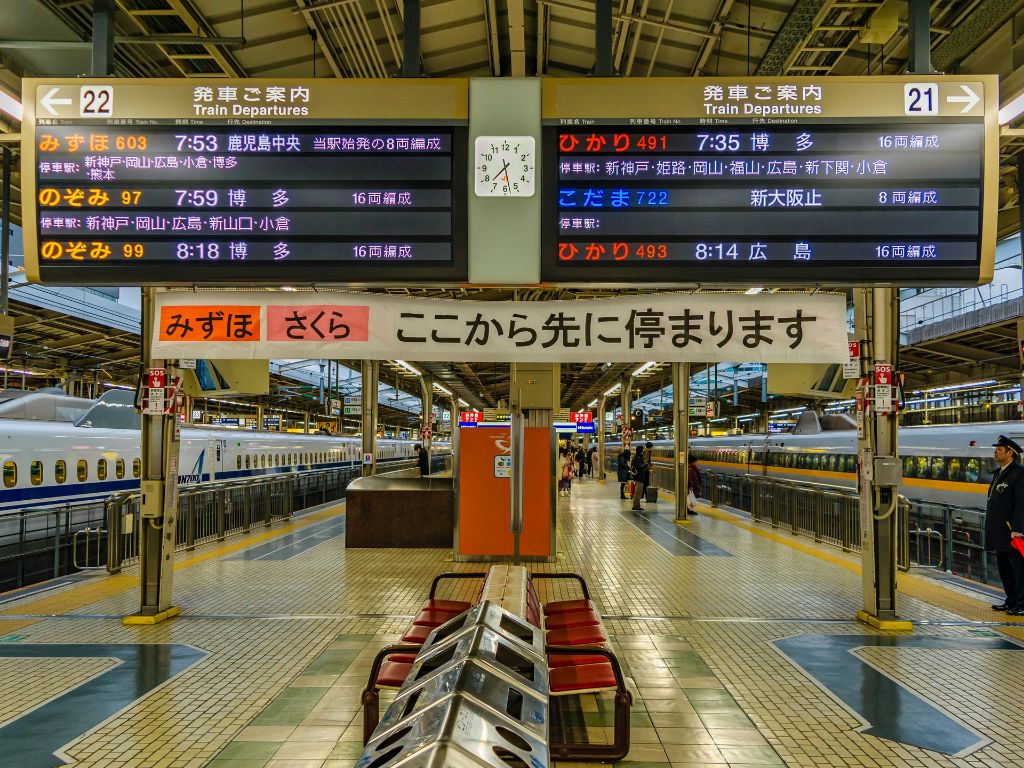
Now, let’s get into how to get around Osaka and how much it costs. Osaka (and Japan in general) has one of the best train and transportation systems in the world; not only is it convenient and vast, but it’s also punctual and fast. Needless to say, the best way to get around Osaka and Japan is by train.
Buses are also readily available and are convenient to use. Taxis are an option too, but I wouldn’t use them unless it’s necessary, nor would I rent a car; it’s not worth it when it’s faster and easier to travel by train. Osaka is also quite a large city, with an area of 225 square kilometers, so I would only recommend walking if it’s not too long of a distance.
While the cost of transportation is pretty affordable, it can add up (depending on how much you travel). Taking the subway or new tram one-way costs anywhere from $1.36 USD to $2.79 USD. Here are some examples of the costs of traveling in Osaka:
- A train from Namba Station to Osaka Castle costs $1.72 USD
- A train from Tennoji Station to Umeda Station costs $2.08 USD
- A train from Umeda Station to Kyoto Station costs $4.15 USD
- A train from Namba Station to Kobe Station costs $5 USD
SIM Cards and Data
Lastly, let’s go over the cost of SIM cards and data in Osaka. Unfortunately, Japan doesn’t let visitors purchase SIM cards with text and call packages. But, travelers can buy prepaid data-only SIM cards.
If you need to be able to call and text on your phone with a Japanese SIM card, you’ll first need to check that your phone can work in Japan, then you’ll need a piece of Japanese identification (a residence card or Japanese driver’s license) and a Japanese address. I personally found this process too cumbersome, so I never got a SIM card and I had no issues getting by.
If you’re comfortable with only getting a prepaid data-only SIM card, they’re quite easy to get.
You can buy one from Yodobashi Camera shops, airports, and convenience stores and all you need is an unlocked cellphone. Some companies offering prepaid data-only SIM cards include SoftBank Japan, Bmobile Japan, IIJmio Japan Travel SIM, Sakura Mobile, and Nippon SIM for Japan.
For 30-day plans, you can expect to pay a minimum of $15.72 USD for 1.5 GB of data, $23.58 USD for 3 GB of data, and $56.60 USD for unlimited data. Click here for some price comparisons.
Money Saving Tips for Osaka
As you can see, while the living costs in Osaka aren’t ridiculously high, they aren’t particularly cheap either (especially compared to countries in Southeast Asia). So, if you’re worried about how much it costs to live in Osaka, here are some ways that you can save money:
- Visit grocery stores shortly before they close. This is when they’ll provide the best deals (from 10% to 50% off) on their ready-to-eat food such as sushi, lunch boxes, and more.
- If you plan on traveling the same train route frequently, look into getting a commuter pass. This pass will allow you to travel between two specific train stations an infinite amount of times within the month, for a set price.
- Travel within Japan using night buses instead of the Shinkansen (bullet train) or airplane. It’s the cheapest way to travel, and my favorite way to get to Tokyo from Osaka.
- Opt to stay in a share house instead of a private apartment. Not only is it cheaper, but it’ll be easier to find and make friends with fellow expats.
- Purchase local foods and goods instead of imported items, and lower your fruit intake.
Coworking Spaces in Osaka and Wifi Speed

If you’re planning on working remotely in Osaka, you might be wondering about Osaka’s WiFi speed and available co-working spaces. According to speedtest.net, the median download speed is 46.38 Mbps, the median upload speed is 8.84 Mbps, and the median latency is 38 ms.
The WiFi is solid and dependable, and you can frequently find usable WiFi at cafes, hotels, and convenience stores.
However, if you’re looking for a stronger WiFi connection, you can always check out Osaka’s co-working spaces. Here are five highly-rated co-working spaces that I recommend checking out:
- Osakan Space: For a welcoming, quiet, and relaxing co-working space located in Kita (Umeda), I recommend using Osakan Space. With both social and quiet areas and high-speed internet, it’s the perfect place to work and socialize. Open from 10 am – 6 pm. A one-day pass costs 2,200 JPY ($15.70 USD), and a one-month pass costs 16,500 JPY ($117.74 USD).
- The DECK: For a comfortable co-working space with high-speed internet, free-to-use monitors, complimentary drinks, and a spacious and sleek design, you have to check out the DECK. It is open from 9 am – 6 pm Monday to Friday and 10 am – 6 pm on weekends. It costs $16 USD per day, $50 USD per week, or $100 USD per month.
- WeWork Namba SkyO: If you’re looking for one of the best co-working spaces in Minami (Namba), then look no further than WeWork Namba SkyO. While signing up for WeWork is more complicated than the other co-working spaces and involves a contract, WeWork Namba SkyO offers large and spacious common areas, high-speed WiFi, complimentary drinks, and stunning views. Open from 8:30 am – 6 pm on weekdays. You have to inquire about the costs.
- INOVE Shared Office Honmachi: For a large and comfortable co-working space in Honmachi with friendly, English-speaking staff, various seating options, and high-speed internet, check out INOVE Shared Office Honmachi. Open from 9 am – 5 pm (for drop-in visits). A one-day drop in pass costs 1,000 JPY ($7.13 USD).
- ONthe UMEDA: Located in the center of Umeda, ONthe UMEDA is a convenient and spacious co-working space with friendly and welcoming staff, complimentary drinks, high-speed internet, and an inspiring environment. Open from 8:30 am – 9 pm. A one-day drop-in pass costs 4,000 JPY ($28.56 USD).
Activities and Things To Do in Osaka

While there are many allures of simply living in the city, there are plenty of things to do in Osaka to keep you entertained. You can’t live in one of Japan’s most exciting and bustling areas without doing these five things:
1. Explore, Shop, and Eat Around the Dotonbori Canal
One of Osaka’s most popular and iconic sights is the Dotonbori Canal. Filled with flashy neon signs (including the famous Glico Running Man sign), a vast array of unique shops, and mouthwatering street food, the Dotonbori Canal is the center of Osaka’s nightlife.
Located in Minami (Namba), Dotonbori is easy to walk to from the Namba train station. It’s also the best place to experience Osaka’s bar scene. While I don’t have much experience with the bars and clubs of Dotonbori (I’m not much of a drinker), I hear that Dotonbori’s nightlife is both lively and exhilarating.
If, like me, you don’t like going out much, there’s still plenty to do in Dotonbori. I recommend getting lost in Dotonbori’s back streets and exploring the canal-side shops (including Don Quijote, my favorite bargain shop).
2. Wander the Grounds of Osaka Castle Park
Next, my absolute favorite thing to do in Osaka is to visit the majestic Osaka Castle. Initially constructed in 1583 under Hideyoshi Toyotomi, it has a long and tumultuous history that you can learn about in its history museum. It’s easy to get to by train; to get there from Namba, take the JR West Osaka Loop Line and get off at Osakajokoen Station.
I adore visiting Osaka Castle for its vast and enchanting park. An oasis in the heart of Osaka, the park features gardens, cherry blossoms, plum blossoms, and a moat. Have a look at this guided walking tour which takes in the Osaka Castle.
3. Book a Food Tour Around Shinsekai
If you’ve just arrived in Osaka and you want to get a taste of the city, I recommend booking this Osaka: Shinsekai Food Tour. Taking you to some of the most delicious and authentic restaurants in the Shinsekai neighborhood, you’ll get a taste of some of Japan’s best dishes, including takoyaki, udon, yakitori, edamame, karaage, and gyoza.
This is without a doubt the best way to introduce yourself to Osaka and all it has to offer, so I definitely recommend checking it out. To learn more and book the tour, click here.
4. Visit the Serene and Picturesque Shitenno-ji Temple
If you’re interested in visiting one of the oldest Buddhist temples in Japan, then look no further than Shitenno-ji Temple. Constructed in 593 under Prince Shotoku, Shitenno-ji Temple is the first Japanese Buddhist temple to be built by the state.
Located in Tennoji, Shitenno-ji Temple is easy to get to. You can walk there from Tennoji Station in under ten minutes, or get off at the Shitennoji-mae-Yuhigaoka subway station. Not only is the temple beautiful, but it also holds a lovely pond and delightful gardens.
If possible, I recommend visiting Shitenno-ji Temple on the 21st of the month when it hosts a bustling flea market filled with fascinating goods. I actually stumbled across it when I visited. Needless to say, I was quite shocked at the temple crowds on a Tuesday morning.
5. Spend an Exhilarating Day at Universal Studios Japan
Last but not least, one of Osaka’s greatest attractions is the thrilling Universal Studios Japan (USJ for short). Spending a full day at USJ was always a highlight of my trip as a child, and it still is – you’re never too old to enjoy the screams and thrills of this amazing theme park.
I definitely recommend going on the Jurassic Park ride, Jaws ride, and Space Fantasy ride while you’re there. And don’t forget about the newer rides like Mario Kart: Koopa’s Challenge and the Flying Dinosaur.
USJ is also easy to get to by taking the train to Universal City Station. If you’re interested in booking an entry pass in advance, click here.
Weather in Osaka
Osaka has a temperate climate with hot, wet summers and cold, dry winters. Since there’s little precipitation in the winter, Osaka rarely sees snow.
The coldest months are from December to March, with the average temperatures varying between 5°C to 9°C (41°F to 48.2°F). The hottest months are from June to September, with the average temperatures varying between 23°C to 28°C (73.4°F to 82.4°F). Osaka only tends to get an average rainfall of 1,300 millimeters (51 inches) per year.
In my opinion, the best times to visit Osaka are in the spring and fall. Not only is the weather the most ideal, but these are the perfect times to admire Osaka’s cherry blossoms and autumn foliage. So if possible, spend your time exploring Osaka in late March and early April, and November.
The worst times to visit Osaka tend to be in July and August when the tourists are most present and the weather the most oppressive. I would also recommend avoiding Osaka in August and September since it’s peak typhoon season.
Pros and Cons of Living in Osaka
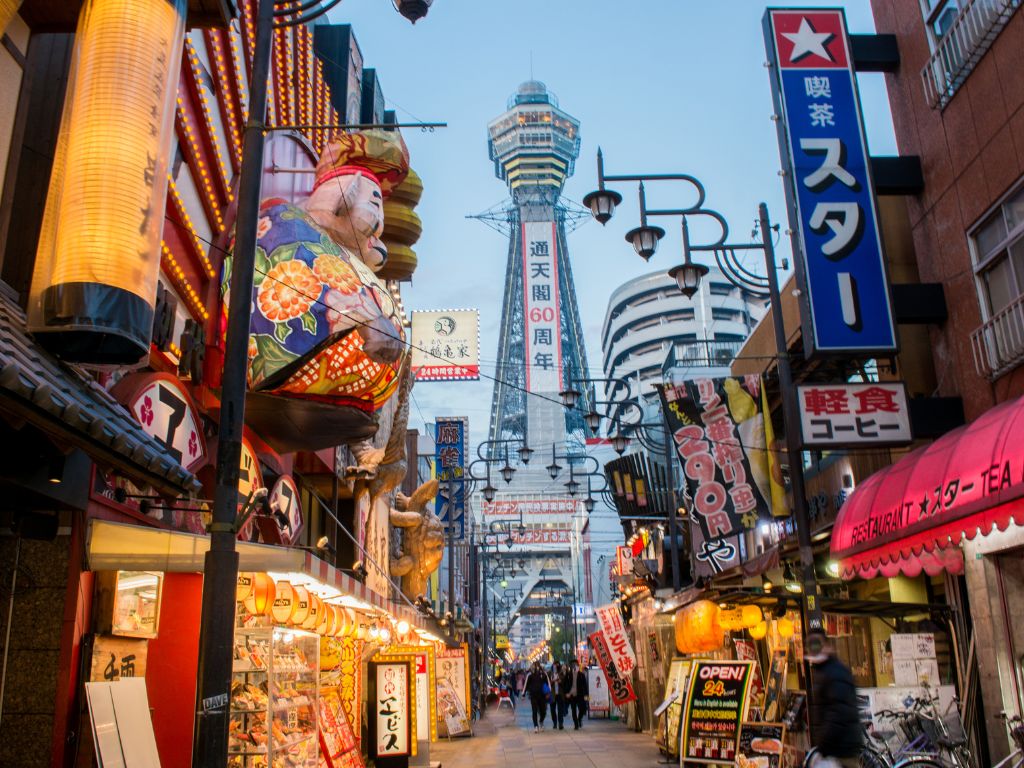
As with anywhere in the world, there are both pros and cons of living in Osaka:
Pros of Living in Osaka
- Endless Things to Do: From its expansive shopping spots to its countless historic temples, you’ll never get bored with Osaka’s sights.
- Delicious and Cheap Street Food: My favorite part of living in Osaka was being able to frequently enjoy some mouthwatering street food, including takoyaki and okonomiyaki.
- Convenient and Dependable Public Transportation: Japan has one of the best train systems in the world, and it’s easy to quickly get around the city using Osaka’s trains, subways, trams, and buses.
- Incredible Day Trips: Osaka is conveniently close to some of the most beautiful places in Japan, including Kyoto, Nara, Mount Koya, and Himeji.
- Safe: As one of the safest cities in the world, you don’t have to worry about petty thievery, mugging, or scams in Osaka.
Cons of Living in Osaka
- Cost of Living: While Osaka isn’t particularly expensive, it is significantly pricier than living in other areas of Asia, such as Vietnam, Thailand, Indonesia, and the Philippines.
- Many Smokers: If you’re a non-smoker like myself, the prevalence of smoking in Osaka can get on your nerves. And while Osaka is trying to eradicate street smoking and provides separate smoking zones, it isn’t uncommon to get some second-hand smoke.
- Cockroaches: Growing up in Vancouver, I’d never experienced life with cockroaches before living in Japan. And while I don’t consider myself to be a squeamish person, nothing has scared me more than seeing a cockroach roaming the kitchen at night. Be prepared to face them in the summer months.
- It Can Get Crowded: As the third largest city in Japan, and a popular tourist spot for domestic and international travelers, the Osakan crowds can get overwhelming.
Digital Nomad Visa for Japan

Let’s finish off this digital nomad guide to Osaka by discussing the available visas for remote workers. Unfortunately, Japan doesn’t offer visas specifically for digital nomads. However, there are other ways of living in Osaka as a foreigner.
For American, British, and Canadian visitors, you can stay in Japan for up to 90 days without a visa. In my opinion, this is the easiest way to live in Osaka as a digital nomad. While your time living abroad in Japan is limited to 3 months, you get to skip out on dealing with Japan’s bureaucracy.
Japan also offers working holiday visas and work visas, but it is unlikely that you’ll receive approval as a remote worker. Nevertheless, there are some rumors that Japan will be introducing a digital nomad visa soon!
In Conclusion
I hope this digital nomad guide on living in Osaka has provided you with a better idea of what your life would look like in one of Japan’s most lively cities.
While the process of relocating to a new city, seeking accommodations, getting a SIM card, finding a regular co-working space, and potentially dealing with Japan’s frustrating and over-complicated bureaucracy can be a hassle, it’s definitely worth it.
Regardless of whether you’re planning to stay in Osaka for a month or a year, Osaka has something to offer for every type of traveler: a thriving nightlife, tranquil parks, vast shopping districts, and ancient shrines to name a few. So pack up your bags and grab your passports, I’m sure you’ll have an incredible time.
